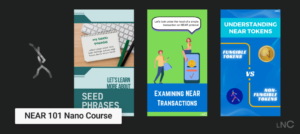IMPORANT UPDATE
TON becomes the exclusive blockchain infrastructure powering Telegram’s Mini App ecosystem and supporting Telegram’s global user base of over 950 million monthly active users. Please carefully review Developer guidelines
NEAR Protocol And The Open Network (TON)
NEAR and TON (The Open Network) are two of the most promising projects in the crypto ecosystem. NEAR offers users built-in features that include account abstraction and named accounts. The dApp (decentralized application) platform focused on user and developer-friendliness and was built by the NEAR Collective. On the other hand, TON is a decentralized layer-1 blockchain created by Telegram in 2018. However, it was abandoned shortly after.
This article will examine each project in more detail, including how it works, its ecosystem, uses, and more.
What is NEAR?
NEAR is a smart contract-capable, public Proof-of-Stake blockchain that provides developers with a platform for building decentralized applications (dApps). Built by the NEAR Collective, it competes primarily with Ethereum and other smart contract-enabled blockchains such as EOS and Polkadot. The protocol aims to improve upon Ethereum’s shortcomings in speed, scalability, and cost.
NEAR is faster and cheaper than Ethereum, processing up to 100,000 transactions per second. The protocol’s incredible scalability has the potential to revolutionize the world of smart contracts and decentralized applications. Key to the NEAR Protocol’s design and way of functioning is a concept called sharding. Sharding splits a network’s infrastructure into smaller segments, allowing nodes to handle only a fraction of the network’s total transactions. Sharding can create a more efficient way to retrieve network data and help scale the platform.
NEAR can be compared to data storage systems such as Amazon Web Services (AWS), which act as the base layer upon which applications are built. However, the critical difference is that NEAR is decentralized and maintained by a distributed network of computers (nodes). The protocol’s native token, NEAR, is used to pay for transaction fees and storage. Token holders can also stake their tokens, assuming the role of validators and helping the network achieve consensus.
The NEAR Collective
The NEAR Collective is the entity behind the NEAR Protocol and consists of individual organizations and other contributors who constantly work to improve it. The organization works on projects, writing their initial code and helping with their implementation on NEAR. The NEAR Collective also helps in development and governance activities. While the NEAR Collective has developed NEAR, the protocol is entirely decentralized. It operates independently and cannot be shut down or manipulated.
How does the NEAR Protocol work?
NEAR Protocol is a Proof-of-Stake blockchain. The Proof-of-Stake mechanism requires token holders to stake a certain number of tokens to be eligible to validate blocks. Key to the protocol’s functioning is its consensus algorithm – Nightshade.
Nightshade
Nightshade is NEAR Protocol’s sharding solution, which allows NEAR to distribute the computational workload into manageable chunks. Thanks to Nightshade, each participating node must store only a small subset of the platform’s data. Nodes can then process these ‘chunks’ of information and add them to the main chain.
One of Nightshade’s main benefits is that it significantly reduces the number of potential points of failure. This is because each node is responsible for only a small amount of data and maintains only a small portion of the chain, greatly increasing efficiency.
What is NEAR’s consensus algorithm?
Validators also play a crucial role on NEAR and are responsible for maintaining consensus within the protocol. They must keep their servers online at all times and their systems updated. Validators are determined in every new epoch and are elected based on their stake. Validators who have already been elected can be re-elected by re-staking their tokens and accrued rewards. Meanwhile, any potential validator must have their stake above a predetermined level.
What are NEAR Accounts?
As mentioned earlier, NEAR supports human-readable addresses. There are two types of NEAR accounts: Implicit addresses and Named addresses.
Implicit Address
Implicit address accounts are denoted by a 64-character address corresponding to a public/private key pair. To use this type of account, users must fund it with their NEAR tokens or pay the gas fee for the transaction.
Named Address
NEAR also allows users to register named accounts that are much simpler to share and remember. Named accounts can also create sub-accounts, effectively acting as domains.
What Is TON?
TON (Toncoin) was originally built by Telegram in 2018. At the time of its creation, Telegram raised $1.7 billion in private funding for its new blockchain, intended as a competitor to Ethereum. However, it abandoned the project after the United States Securities and Exchange Commission entered the picture and sued, alleging that $TON, its native token, was a security. After Telegram abandoned the project, it was picked up by developers unaffiliated with Telegram, taking over the ton.org domain name and the Toncoin code repository. Toncoin then launched the TON blockchain and the TON token.
TON is short for:
TON is a decentralized Layer1 smart contract network created for financial applications and NFTs. So far, over a million NFTs have been minted. Like NEAR, TON is a Proof-of-Stake blockchain that delivers a highly scalable network ideal for financial transactions. It also facilitates interactions between users over an immutable financial infrastructure. The TON blockchain stands out for its scalability and high performance. It created a record of sorts when it processed 55,000 transactions per second, which was made possible by its unique multi-level architecture, combining the main chain with multiple other word chains.
How Does TON Work?
Four aspects are crucial to TON’s functioning: proof-of-stake consensus, Sharding, the TON Virtual Machine, and its native token, Toncoin.
Proof-of-Stake Consensus
Consensus is how nodes on the network agree upon the current and valid state of the network. TON uses the energy-efficient Proof-of-Stake consensus mechanism. Validators can stake their tokens and earn rewards for their contribution to securing the network. At the time of writing, TON has 329 validators and 511,880,772 $TON staked. Validators receive $TON tokens for each block they validate. TON’s Block-Proof-of-Stake ensures that the network continues to run even if all validators cannot participate in the consensus.
Sharding
Sharding helps increase blockchain scalability and is also used by NEAR. Sharding divides TON into smaller components called shards. Each shard is assigned a specific role, helping the blockchain maintain a global state. Maintaining a global state helps eliminate the need for network nodes to process every transaction, bringing in greater efficiency.
The TON Virtual Machine (TVM)
The TON Virtual Machine plays a role similar to that of the Ethereum Virtual Machine, computing commands from contract applications and changing the network state after each execution. Through the TVM, developers can create applications that can automate various processes, such as asset minting, asset transfers, and signing messages on the network.
Toncoin
Toncoin ($TON) is the native cryptocurrency of TON and has multiple uses in the TON ecosystem. The token is used to pay transaction fees, staking, and protocol governance.
Transaction Fees
The $TON token is used to pay for transactions on the TON Network. Users must use the tokens to process transactions or pay gas fees. The token is also used to pay for TON Network storage and blockchain-based domain names.
Governance
The $TON token plays a crucial role in governance. $TON token holders can vote on proposals and have a say in the network’s future.
Staking
$TON token holders can also stake their tokens, acting as validators, helping to validate transactions and secure the network. Users can stake their tokens directly on the network or through major cryptocurrency exchanges.
What consensus mechanism do NEAR and TON use?
Future Plans For NEAR and TON
NEAR – User-Owned AI
NEAR is advancing User-Owned AI by integrating AI research and applications into its blockchain ecosystem. The NEAR.AI R&D Lab aims to develop AI that creates end-to-end Web3 applications from user intents. By leveraging its large user base, developer ecosystem, and financial resources, NEAR seeks to attract top AI talent and build a decentralized AI infrastructure that empowers users and communities.
TON – Further Telegram Integrations
The expansion of TON’s utility within Telegram is undoubtedly the most exciting thing about TONCoin. As per Telegram Founder Pavel Durov, users will be able to pay for advertising in TON and tip channel administrators. Soon, stickers can be bought and sold as NFTs, with artists receiving 95% of the proceeds. Users will also be able to share TON, log into accounts using crypto wallets, and register and sell account names.
In Closing
NEAR and TON are innovative platforms that have revolutionized the dApp and smart contract landscape. With its focus on speed, scalability, and user-developer friendliness, NEAR has emerged as a worthy alternative to Ethereum. Meanwhile, TON is rapidly attracting investors and developers. Its Telegram integration also gives the network access to over 700 million potential users.
Vote NOW!
Please login to see this form
Updated: January 22, 2025





Top comment
It's interesting to see how NEAR and TON have been making waves in the dApp and smart contract landscape. Both platforms have unique features that make them stand out from other options.NEAR's focus on speed and scalability is definitely a major advantage, as these are important factors for many dApps and smart contracts. Additionally, its user-developer friendliness is a great feature that can help attract more developers to the platform.TON, on the other hand, is rapidly gaining attention from investors and developers, which is a good sign. Its Telegram integration is also a smart move, as it gives the network access to a large potential user base.Overall, it's exciting to see how these platforms are innovating and pushing the boundaries of what's possible in the dApp and smart contract space. It will be interesting to see how they continue to evolve and grow in the future.
Thanks for useful information! 🙂
BiG uP both ecosystems !
Facing decentralization issue with Telegram app. Losing access to your phone number, or getting band, it will lead to losing your assets.So make sure don't save your crypto in any apps that's you don't have any contol of your private key.
Makes sense, and it is KYCed if you have Premium
TON have many game and aidrop for user
I feel TON and NEAR are like 5&6
Ýe i am to great
really good written
Top great material
Good project and like this
Top great material